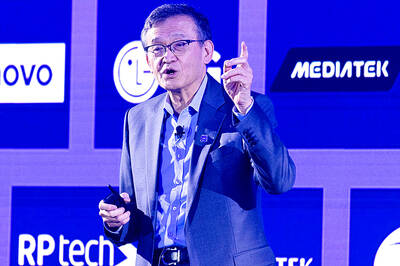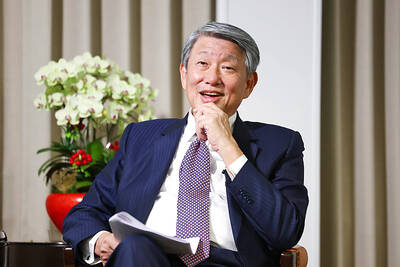Powerchip Semiconductor Corp (力晶半導體), the nation’s top maker of memory chips used in computers, yesterday posted record quarterly losses as a deteriorating economy added pressure to the industry’s most severe slump on a glut after demand dwindled unexpectedly.
During the third quarter, the Hsinchu-based company’s quarterly net losses swelled to NT$15.02 billion (US$459.4 million), marking the sixth consecutive quarterly losses. The company reported a net loss of NT$1.9 billion a year ago and NT$7.27 billion in loss for the second quarter.
“After one-and-a-half years of digestion of excessive supply, I had thought supply would have matched demand in the second half. But the global financial crisis” changed all that, company chairman Frank Huang (黃崇仁) told investors.
CUT
Huang said a joint output cut among memory chipmakers could help the industry hit bottom in the current or next quarter.
To cope with bleak industry prospects, Powerchip said it would cut spending on new equipment by more than two-thirds next year to less than NT$10 billion, compared with NT$34.5 billion planned for this year, company president Brian Hsieh (謝再居) said.
Powerchip said it would also suspend construction of a new advanced plant, which was scheduled to begin production next year, he said.
“If you ask me when spring will come, I’ve got no answer. We are now in an ice age rather than in harsh winter as you were told [three months ago],” Hsieh said. “It is turning into a survival game.”
In the third quarter alone, the price of benchmark dynamic random access memory (DRAM) chips plunged about 38 percent to average at US$1.23 per unit after plunging 85 percent last year on severe glut, Taipei-based market researcher DRAMeXchange Technology Inc (集邦科技) said.
“Our efforts now are focusing on maintaining cash balance, which is crucial [to weathering the downturn], as well as more cost saving measures,” Hsieh told investors, who saw cash position as a crucial factor in surviving the downcycle in the DRAM industry.
The reduction in capital spending would bring down annual output growth to about 30 percent to 40 percent next year, compared to 65 percent expansion this year and 90 percent last year, Powerchip said.
“The plan to sharply cut capital spending along with more cost-saving efforts will assure investors that the company will not disappear,” said Kenneth Yang (楊克勤), a semiconductor analyst at Primasia Securities Co.
Regarding the third quarter, Powerchip has NT$17.6 billion in cash and tradable securities on hand.
STRATEGY
In the final quarter of this year, Powerchip also intends to cut another 10 percent to 15 percent in output by temporarily shutting down less cost-efficient plants and encouraging employees to go on leave.
Powerchip hopes to accomplish further output reduction, which could drive up chip prices, and to migrate more manufacturing to next-generation plants to give it an edge over its competitors.
Shares of Powerchip rose 0.42 percent to NT$4.77 yesterday, outperforming the benchmark TAIEX index, which was up 0.22 percent.

Nvidia Corp CEO Jensen Huang (黃仁勳) today announced that his company has selected "Beitou Shilin" in Taipei for its new Taiwan office, called Nvidia Constellation, putting an end to months of speculation. Industry sources have said that the tech giant has been eyeing the Beitou Shilin Science Park as the site of its new overseas headquarters, and speculated that the new headquarters would be built on two plots of land designated as "T17" and "T18," which span 3.89 hectares in the park. "I think it's time for us to reveal one of the largest products we've ever built," Huang said near the

China yesterday announced anti-dumping duties as high as 74.9 percent on imports of polyoxymethylene (POM) copolymers, a type of engineering plastic, from Taiwan, the US, the EU and Japan. The Chinese Ministry of Commerce’s findings conclude a probe launched in May last year, shortly after the US sharply increased tariffs on Chinese electric vehicles, computer chips and other imports. POM copolymers can partially replace metals such as copper and zinc, and have various applications, including in auto parts, electronics and medical equipment, the Chinese ministry has said. In January, it said initial investigations had determined that dumping was taking place, and implemented preliminary

Intel Corp yesterday reinforced its determination to strengthen its partnerships with Taiwan’s ecosystem partners including original-electronic-manufacturing (OEM) companies such as Hon Hai Precision Industry Co (鴻海精密) and chipmaker United Microelectronics Corp (UMC, 聯電). “Tonight marks a new beginning. We renew our new partnership with Taiwan ecosystem,” Intel new chief executive officer Tan Lip-bu (陳立武) said at a dinner with representatives from the company’s local partners, celebrating the 40th anniversary of the US chip giant’s presence in Taiwan. Tan took the reins at Intel six weeks ago aiming to reform the chipmaker and revive its past glory. This is the first time Tan

CUSTOMERS’ BURDEN: TSMC already has operations in the US and is a foundry, so any tariff increase would mostly affect US customers, not the company, the minister said Taiwanese manufacturers are “not afraid” of US tariffs, but are concerned about being affected more heavily than regional economic competitors Japan and South Korea, Minister of Economic Affairs J.W. Kuo (郭智輝) said. “Taiwan has many advantages that other countries do not have, the most notable of which is its semiconductor ecosystem,” Kuo said. The US “must rely on Taiwan” to boost its microchip manufacturing capacities, Kuo said in an interview ahead of his one-year anniversary in office tomorrow. Taiwan has submitted a position paper under Section 232 of the US Trade Expansion Act to explain the “complementary relationship” between Taiwan and the US